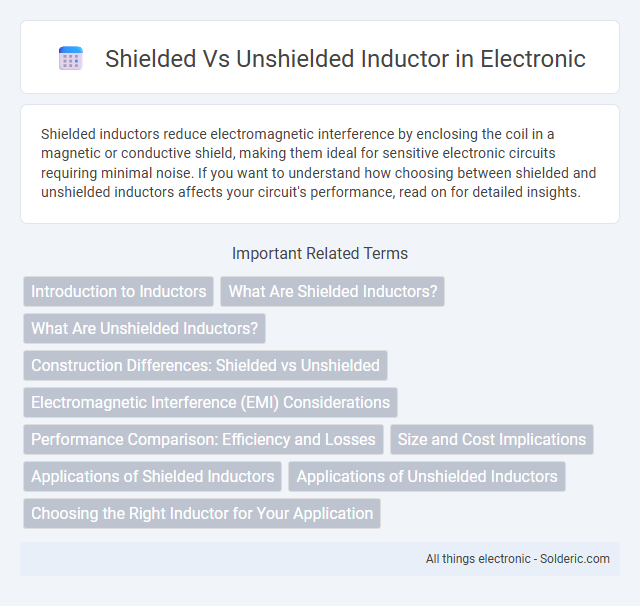Shielded inductors reduce electromagnetic interference by enclosing the coil in a magnetic or conductive shield, making them ideal for sensitive electronic circuits requiring minimal noise. If you want to understand how choosing between shielded and unshielded inductors affects your circuit's performance, read on for detailed insights.
Comparison Table
| Feature | Shielded Inductor | Unshielded Inductor |
|---|---|---|
| Magnetic Shielding | Yes, reduces electromagnetic interference (EMI) | No, higher EMI emissions |
| EMI Emissions | Low, suitable for sensitive circuits | High, may cause signal interference |
| Size | Typically larger due to shielding casing | Smaller and more compact |
| Cost | Higher cost due to extra materials | Lower cost, simpler construction |
| Inductance Stability | More stable with minimal external disturbances | Less stable, affected by nearby components |
| Applications | Audio equipment, RF circuits, EMI sensitive devices | General power supplies, non-critical circuits |
Introduction to Inductors
Inductors are passive electrical components designed to store energy in a magnetic field when electrical current flows through them. Shielded inductors feature a magnetic core or enclosure that minimizes electromagnetic interference (EMI), enhancing performance in sensitive circuits, while unshielded inductors lack such protection, making them more prone to causing or receiving interference. Choosing between shielded and unshielded inductors impacts your circuit's noise immunity and overall electromagnetic compatibility (EMC).
What Are Shielded Inductors?
Shielded inductors feature a magnetic shielding casing, typically made from ferromagnetic materials, which confines the magnetic field within the component, reducing electromagnetic interference (EMI) with nearby sensitive electronics. This shielding improves performance stability and limits signal noise, making shielded inductors ideal for high-frequency and precision applications. In contrast, unshielded inductors lack this magnetic enclosure, resulting in higher EMI emissions and potential interference issues in dense circuit environments.
What Are Unshielded Inductors?
Unshielded inductors are electromagnetic components that lack a magnetic shield, causing their magnetic fields to extend freely into the surrounding environment. These inductors are typically used when cost efficiency and ease of manufacture are prioritized over electromagnetic interference (EMI) control. Unshielded inductors can induce noise or interference in nearby circuits, making them less suitable for sensitive electronic applications compared to their shielded counterparts.
Construction Differences: Shielded vs Unshielded
Shielded inductors feature a magnetic enclosure or foil barrier that confines electromagnetic interference (EMI), reducing noise and preventing coupling with nearby components. Unshielded inductors lack this protective barrier, resulting in higher EMI emissions and susceptibility to external noise but often provide better heat dissipation due to open construction. The shielded design utilizes ferrite or metal shields, enhancing electromagnetic compatibility (EMC) in tightly packed circuits, while unshielded inductors rely on coil geometry and spacing to mitigate interference.
Electromagnetic Interference (EMI) Considerations
Shielded inductors significantly reduce Electromagnetic Interference (EMI) by containing magnetic fields within a metal casing or magnetic shield, minimizing noise emission and susceptibility in sensitive electronic circuits. Unshielded inductors lack this protective enclosure, allowing magnetic fields to radiate freely, which can cause interference with nearby components and degrade overall system performance. Proper selection between shielded and unshielded inductors is critical in designs requiring low EMI, such as communication and precision measurement devices.
Performance Comparison: Efficiency and Losses
Shielded inductors exhibit higher efficiency by minimizing electromagnetic interference and reducing core and copper losses, resulting in improved performance in high-frequency applications. Unshielded inductors may experience increased energy losses due to magnetic flux leakage and external interference, diminishing overall efficiency. Selecting shielded inductors enhances circuit reliability and power conversion efficiency, especially in compact, noise-sensitive environments.
Size and Cost Implications
Shielded inductors generally have larger physical sizes due to the added magnetic shielding materials, which increases manufacturing complexity and cost compared to unshielded inductors. Unshielded inductors tend to be smaller and more cost-effective but may cause electromagnetic interference (EMI) issues in sensitive applications. Choosing between the two involves balancing size constraints, budget, and EMI performance requirements.
Applications of Shielded Inductors
Shielded inductors are ideal for applications requiring minimal electromagnetic interference, such as in sensitive audio equipment, medical devices, and high-frequency communication systems. Their magnetic fields are contained within the shield, reducing noise and crosstalk in densely packed electronic circuits. Choosing shielded inductors enhances Your device's performance by ensuring signal integrity in environments prone to interference.
Applications of Unshielded Inductors
Unshielded inductors are widely used in applications where minimal magnetic field interference is acceptable, such as in power supplies, audio equipment, and RF circuits. Their open magnetic field allows for better heat dissipation and higher inductance values compared to shielded inductors. Common uses include coupling and decoupling, filtering, and energy storage in low-frequency, low-noise environments.
Choosing the Right Inductor for Your Application
Shielded inductors provide superior electromagnetic interference (EMI) reduction, making them ideal for applications requiring minimal noise and compact layouts. Unshielded inductors offer cost-effective solutions with better heat dissipation but may introduce more EMI into sensitive circuits. Selecting the right inductor depends on your circuit's EMI tolerance, space constraints, and thermal management needs.
shielded vs unshielded inductor Infographic

 solderic.com
solderic.com